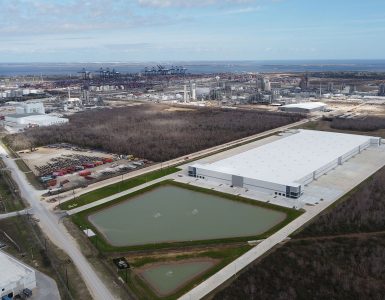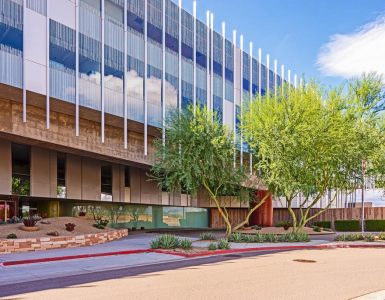In Downtown Houston, a Rebound is Underway, But Where Are the Full-time Office Workers?
Houston Chronicle, May 19, 2022
On weekend nights, Bravery Chef Hall bustles with hipsters sipping cocktails, long lines of millennials salivating over sushi and the occasional violinist in a tuxedo scarfing down on tacos before a concert. Sales have returned to pre-pandemic levels for many of the restaurants in the food hall at the bottom of Aries Market Square.
A quarter mile away, at Finn Hall in the Jones on Main tower, lunch crowds remain subdued. Business is certainly much better, said David Buehrer, who is a part-owner of Greenway Coffee in the hall, but sales at the cafe are still just 60 percent of pre-of pandemic levels as foot traffic remains sparse, particularly Mondays and Fridays when many downtown workers are telecommuting.
The contrast between the two food halls illustrates both the remarkable comeback Houston’s downtown and the challenges it still faces. Two years after lockdowns emptied out the city center, people are again catching Astros’ games at Minute Maid Park, crowding into concerts at Jones Hall and strolling through Discovery Green. But a critical element remains missing: the 168,600 workers that once stampeded into the district every weekday.
The rise of the hybrid workplace, which allows employees to work part of their week at home, is hindering the full recovery of downtown and fundamentally shifting its economy. Once considered a temporary strategy for managing the coronavirus, hybrid schedules are now a permanent policy for many companies downtown, whose employees only commute there a few times week, and often not on Mondays or Fridays.
Not only has remote work dampened sales for dozens of restaurants and service providers in downtown, it also presents new challenges for the residential real estate market, considered a key ingredient for transforming the neighborhood into a 24-7 destination. The question is whether residents will pay premium rents to be downtown when they can work from almost anywhere.
“To think that as a small business owner, like myself, can actually accommodate serving people in a way where everyone’s not there all the time, it’s not going to happen,” said Buehrer, who also is culinary director of Finn Hall. “It’s important to sound the alarm to [city leaders] and say like, ‘You need to fundamentally change what downtown Houston is and you have to do it now.”
Demise of the five-day workweek
Changes to the workforce and workplace will likely require local policy makers to develop new strategies to restore and maintain downtown’s vitality. Thriving downtowns are critical to the health of cities, economic development experts say, providing the civic space for commerce, culture and community to intersect.
Since the lockdowns of early 2020, a lot has changed. Downtown Houston is no longer a ghost town. The number of visits for leisure (as opposed to work) soared to 28.7 million, up 62 percent from 2020, according to Central Houston, a downtown-focused economic development group. In other words, Houstonians are willing to go back to downtown — but just not as much to the office.
Nearly all the biggest employers downtown allow employees to work remotely at least part of the time. As a result, most employees are only commuting to work Tuesdays through Thursdays, according to office building landlords.
Office occupancy was just 53 percent in April, up from 29 percent a year earlier, according to Central Houston. Three of downtown’s major office landlords — Brookfield Properties, Hines and Lionstone Investments — said most of their tenants are back to the office, but typically no more than three days a week.
“The dynamics of the five-day work week — what downtown has been shaped by for decades — is inherently different right now,” said Kris Larson, president of Central Houston “For the tunnels and the storefront economies, that means they have fewer days for which they can depend on higher levels of traffic.”
During a recent weekday lunch hour, workers with I.D. badges dangling from their necks streamed through the six-miles of tunnels that connect downtown below ground. But the roar of activity around the underground shops and restaurants disappeared 90 minutes after it started.
On Fridays, sales are “virtually non-existent,” said Forrest Andrews, owner of tunnel restaurant Brown Bag Deli. Several tunnel storefronts are dark. Many advertise vacancies.
Lorett Cuadra snagged one of those vacant spaces to open a women’s clothing boutique, First Dibs, in December. Fifteen years ago, she recalled, crowds filled the tunnels, strangers bumping into strangers, but she doesn’t expect foot traffic to ever get back to that level.
After opening, she made only a couple of sales a day. Sales rose to about 30 a day in March — but still only half of what she anticipated.
“It was a ghost town when we got here,” Cuadra said, “but I’m starting to see it pick up.”
Others are less optimistic. Carl Ross, a 59 year-old architect who has worked in downtown for eight years, thinks the tunnels still seem quiet. The commuter bus he takes from East Houston feels emptier, too.
“It’s eerie still,” said Ross, who works remotely one day a week. “The hybrid model is here to stay because if one company offers it — everyone else [does too].”
At least 20 downtown’s biggest private employers offer hybrid work options for office-based employees, including energy firms Chevron, Shell and Kinder Morgan; engineering firm KBR; financial services firm Chase; and consulting firms Accenture, Deloitte, PwC, Ernst & Young and KPMG. Collectively, the 20 companies account for at least 32,000 employees working downtown — nearly enough to fill the Toyota Center twice.
The demise of the full-time, in-person office worker is forcing businesses to adapt. Those that depend less on office workers start with an advantage. Lunch traffic at Bravery Chef Hall, for example, hasn’t recovered, but the food hall’s location near apartments, hotels and entertainment venues has boosted its dinner and late night business.
“If we were not position in a residential tower like we are, I don’t think we would’ve survived the pandemic,” said Ross, the food hall manager. “Oh, absolutely not.”
Why residential is key
For decades downtown’s economy was shaped around serving office workers. Economic developers, however, have tried to diversify the economic base by promoting downtown as a place to live. Twenty two years ago, 2,000 people called downtown home. Today, more than 10,000 live there.
Still, that’s about one-third of the residents Central Houston estimates it would take to build a self-sustaining neighborhood. With about 5,500 residents per square mile in downtown Houston, the density lags the downtowns of other major cities such as Los Angeles (nearly 13,000 residents per a square mile) and Dallas (about 10,000 residents per a square mile).
“In some ways we’re playing catch up, but we’re also catching up pretty quickly,” said Larson, the Central Houston president.
The rise of remote working, meanwhile, is giving people another option. They no longer have to choose solely between long commutes or paying a premium to live downtown to avoid those commutes. Average asking rents for downtown apartments are about $2,300 a month — about $1,100 more than the regional average of about $1,277, according to commercial real estate firm CoStar.
Vacancy rates across downtown apartments have improved in the past year, but, at nearly 15 percent, they are are almost double the roughly 8 percent in the metropolitan area, according to CoStar. They are likely to rise, too, with the opening of new apartment towers and about 1,300 units under construction, CoStar said.
Some downtown landlords are offering discounts and free rent to attract tenants. For example, Hines is offering at select units up to three months of free rent at Aris Market Square, which is 88 percent occupied and up to 10 weeks of free rent at its new 46-story tower, Brava, which is 25 percent preleased.
Although demand for downtown apartments has improved, Itziar Aguirre, director of market analytics for CoStar in Houston, forecasts leasing will trail pre-pandemic levels this year.
“People aren’t moving back into downtown [in droves] primarily because a lot of those people are still working from home,” said Aguirre. “There is really no reason to pay a lot more when you can have a lot more space or that second bedroom with a home office.”
Camden Downtown, a 21-story apartment tower that opened in 2020, is 95 percent occupied, but charging about 20 percent lower rents than what developers had hoped to achieve, said Ric Campo, CEO of the building’s owner, Camden Property Trust. Rents are about $2.46 per a square foot, below the $3 per a square foot needed to cover construction costs and higher land prices downtown, Campo said.
In part because of the lower-than-expected returns here, Camden isn’t rushing to develop another tower downtown, even though it owns the land to do so.
“Downtown is on sale and it’s been on sale for quite a while now,” Campo said, referring to new apartments in the neighborhood.
The sale could eventually end. Camden is raising rents by 9 percent this year on new leases and renewals downtown, betting that even if tenants don’t have to live downtown for work, plenty are willing to pay to be close to the action.
Downtown, which once emptied out when the work day ended at 5 p.m, is s progressing toward the goal of a 24-hours-a-day neighborhood, said Robert Kramp, vice president at Houston-based real estate firm Transwestern. It’s up to about 18 hours a day.
“Downtown has all of the ingredients to continue to make it a 24-7 destination,” Kramp said. “it just needs more time to mature.”
Designs unveiled for final piece of Stockyards redevelopment
Urbanize Atlanta, May 12, 2022
West Midtown’s Brady Avenue is beginning to look like the next Howell Mill Road. In just the past two weeks, plans have emerged along the relatively quiet Marietta Street Artery backstreet for a massive mixed-use venture that would replace Compound nightclub and a neighboring lounge with 700 homes, and more recently a 14-story office project that would finish the Brickworks retail complex.
Phoenix Adds to Nation’s Highest Multifamily Sales Volume
Connect News, May 6, 2022
Transwestern Development Company (TDC) sold its 209-unit Lydian complex for $66 million. Knightvest Capital purchased the property in what amounted to a unit cost of $313,400 per. TDC’s Brendan O’Leary expected a premium.
A Post-Pandemic Boom in Mixed-Use Mega Projects Is Underway
Wealth Management, May 2, 2022
As some commercial property sectors, most notably office buildings and retail properties, continue to face some challenges post-pandemic, one popular project type—mixed-use—is making a strong comeback. All types of investors, including EB-5 investors, private equity players and publicly traded REITs, like getting on-board with mixed-use properties, many of which involve public-private developments.
Texas Children’s Hospital Reaches Major Milestone in Expanding Service Within Central Texas Market
Medical Construction & Design, May 25, 2022
Texas Children’s Hospital recently celebrated the topping out of the Texas Children’s Hospital North Austin Campus, which will house pediatric care and women’s health services under one roof to better serve patients and their families in the Austin and Central Texas areas.
























